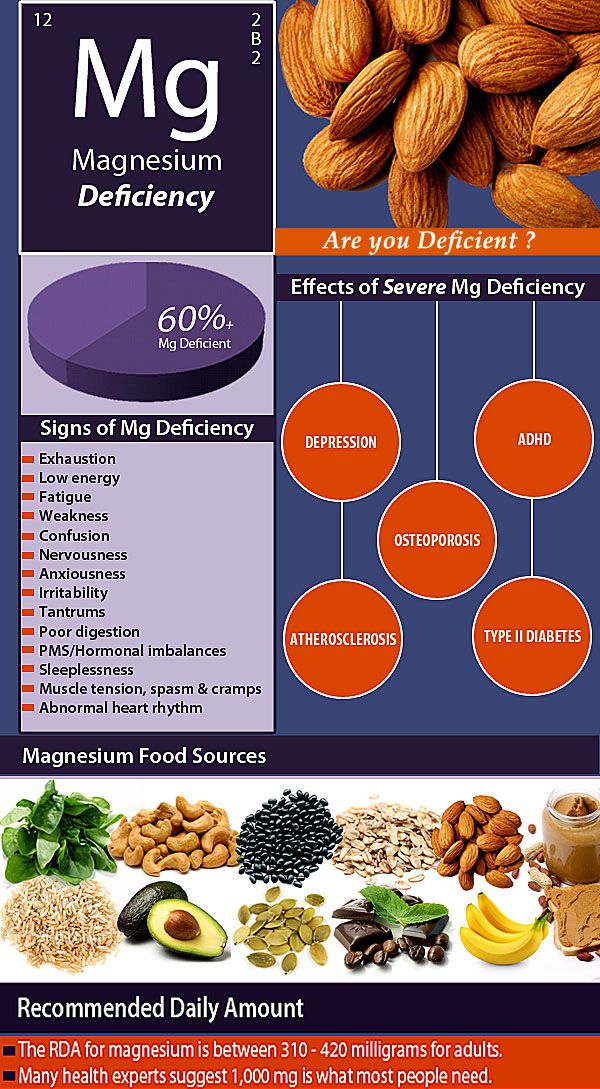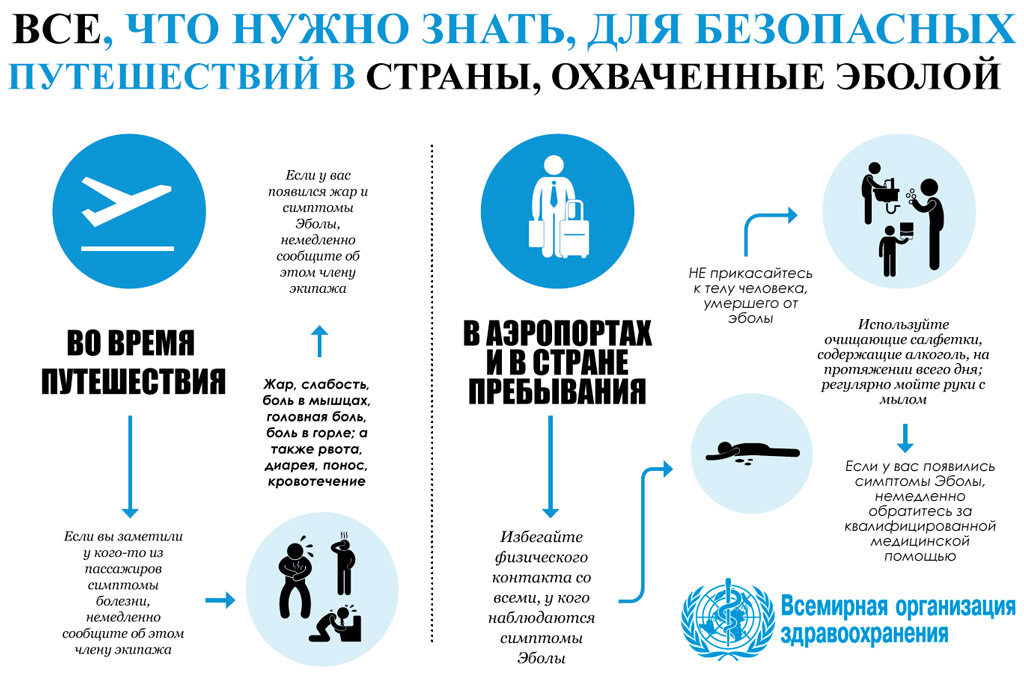Signs of autism at 5 months
"Could My Child Have Autism?" Ten Signs of Possible Autism-Related Delays in 6- to 12-Month-Old Children
tags: Center for Autism and Related Disorders
Though autism is often not diagnosed until the age of three, some children begin to show signs of developmental delay before they turn a year old. While not all infants and toddlers with delays will develop autism spectrum disorders (ASD), experts point to early detection of these signs as key to capitalizing on early diagnosis and intervention, which is believed to improve developmental outcomes.
According to Dr. Rebecca Landa, director of the Center for Autism and Related Disorders at the Kennedy Krieger Institute in Baltimore, Md., parents need to be empowered to identify the warning signs of ASD and other communication delays.
"We want to encourage parents to become good observers of their children's development so that they can see the earliest indicators of delays in a baby's communication, social and motor skills," says Dr. Landa, who also cautions that some children who develop ASD don't show signs until after the second birthday or regress after appearing to develop typically.
For the past decade, Dr. Landa has followed infant siblings of children with autism to identify red flags of the disorder in their earliest form. Her research has shown that diagnosis is possible in some children as young as 14 months and sparked the development of early intervention models that have been shown to improve outcomes for toddlers showing signs of ASD as young as one and two years old.
Dr. Landa recommends that as parents play with their infant (6 - 12 months), they look for the following signs that have been linked to later diagnosis of ASD or other communication disorders:
- Rarely smiles when approached by caregivers
- Rarely tries to imitate sounds and movements others make, such as smiling and laughing, during simple social exchanges
- Delayed or infrequent babbling
- Does not respond to his or her name with increasing consistency from 6 - 12 months
- Does not gesture to communicate by 10 months
- Poor eye contact
- Seeks your attention infrequently
- Repeatedly stiffens arms, hands, legs or displays unusual body movements such as rotating the hands on the wrists, uncommon postures or other repetitive behaviors
- Does not reach up toward you when you reach to pick him or her up
- Delays in motor development, including delayed rolling over, pushing up and crawling
"If parents suspect something is wrong with their child's development, or that their child is losing skills, they should talk to their pediatrician or another developmental expert," says Dr.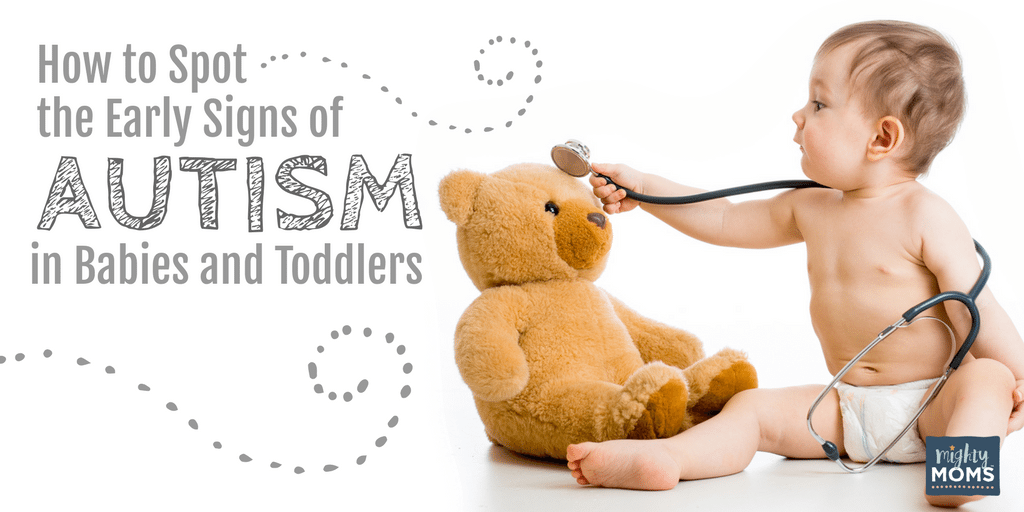 Landa. "Don't adopt a 'wait and see' perspective. We want to identify delays early in development so that intervention can begin when children's brains are more malleable and still developing their circuitry."
Landa. "Don't adopt a 'wait and see' perspective. We want to identify delays early in development so that intervention can begin when children's brains are more malleable and still developing their circuitry."
What are the Early Signs of Autism?
Log in | Register
Health Issues
Health Issues
Listen
Español
Text Size
Many children with autism spectrum disorder (ASD) show developmental differences when they are babies—especially in their social and language skills. Because they usually sit, crawl, and walk on time, less obvious differences in the development of body gestures, pretend play, and social language often go unnoticed.
In addition to speech/language delays and behavioral differences, families may notice differences in the way their child interacts with peers and others.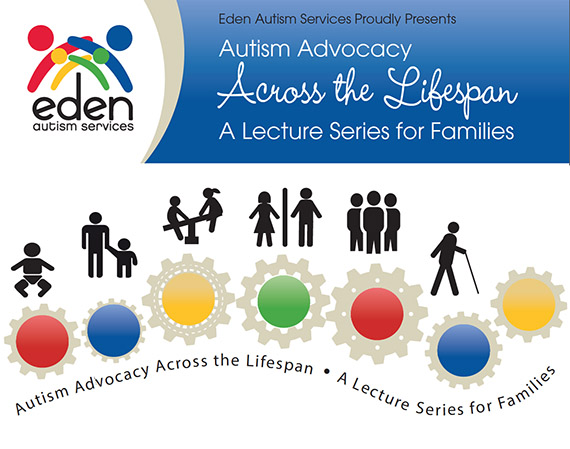
Recognizing signs of autism
Here are some examples of social, communication, and behavioral differences in children with autism.
Keep in mind: one child with ASD will not have exactly the same symptoms as another child with ASD. The number and severity of symptoms can vary a lot!
Social differences in children with autism
May not keep eye contact or makes little or no eye contact
Shows no or less response to a parent's smile or other facial expressions
May not look at objects or events a parent is looking at or pointing to
May not point to objects or events to get a parent to look at them
Less likely to bring objects of personal interest to show to a parent
Many not have appropriate facial expressions
Has difficulty perceiving what others might be thinking or feeling by looking at their facial expressions
Less likely to show concern (empathy) for others
Has difficulty making and keeping friends
Communication differences in children with autism
Less likely to point at things to indicate needs or share things with others
Says no single words by 15 months or 2-word phrases by 24 months
Repeats exactly what others say without understanding the meaning (often called parroting or echoing)
May not respond to name being called but does respond to other sounds (like a car horn or a cat's meow)
May refers to self as "you" and others as "I" and may mix up pronouns
May show no or less interest in communicating
Less likely to start or continue a conversation
Less likely to use toys or other objects to represent people or real life in pretend play
May have a good rote memory, especially for numbers, letters, songs, TV jingles, or a specific topic
May lose language or other social milestones, usually between the ages of 15 and 24 months (often called regression)
Behavioral differences (repetitive & obsessive behaviors) in children with autism
Rocks, spins, sways, twirls fingers, walks on toes for a long time, or flaps hands (called "stereotypic behavior" or stereotypies)
Likes routines, order, and rituals; has difficulty with change or transition from one activity to another
May be obsessed with a few or unusual activities, doing them repeatedly during the day
Plays with parts of toys instead of the whole toy (e.
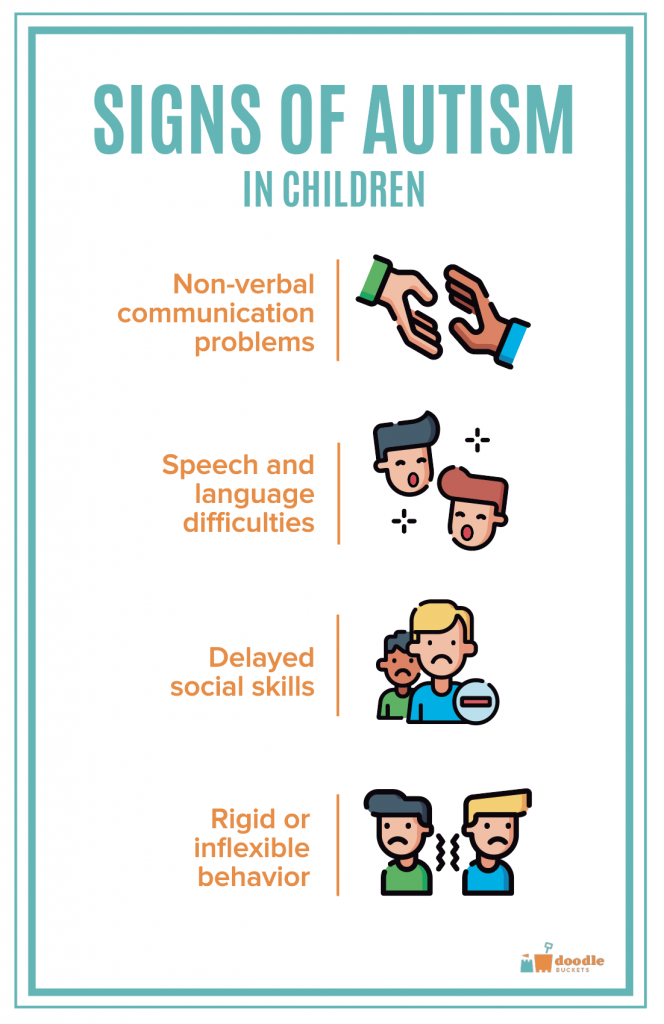 g., spinning the wheels of a toy truck)
g., spinning the wheels of a toy truck)May not cry if in pain or seem to have any fear
May be very sensitive or not sensitive at all to smells, sounds, lights, textures, and touch
May have unusual use of vision or gaze—looks at objects from unusual angles
How to distinguish a child with autism from other typically developing children
Here are some examples that may help a parent tell the difference between normal, age-appropriate behavior and early signs of ASD. Also see When Not to Worry About Autism.
At 12 Months
A child with typical development will turn their head when they hear their name.
A child with ASD might not turn to look, even after their name is repeated several times, but will respond to other sounds.
At 18 Months
A child with delayed speech skills will point, gesture, or use facial expressions to make up for their lack of talking.

A child with ASD might make no attempt to compensate for delayed speech or might limit speech to repeating what they hear on TV or what they just heard.
At 24 Months
A child with typical development brings a picture to show their mother and shares their joy from it with her.
A child with ASD might bring their mom bottle of bubbles to open, but they do not look at her face when they do or share in the pleasure of playing together.
More information
- How Pediatricians Screen for Autism
- Milestones Matter: 10 to Watch for by Age 5
- How to Raise Concerns about a Child's Speech and Language
- What is Early Intervention?
- Language Delays In Toddlers: Information for Parents
-
Learn the Signs. Act Early (CDC.
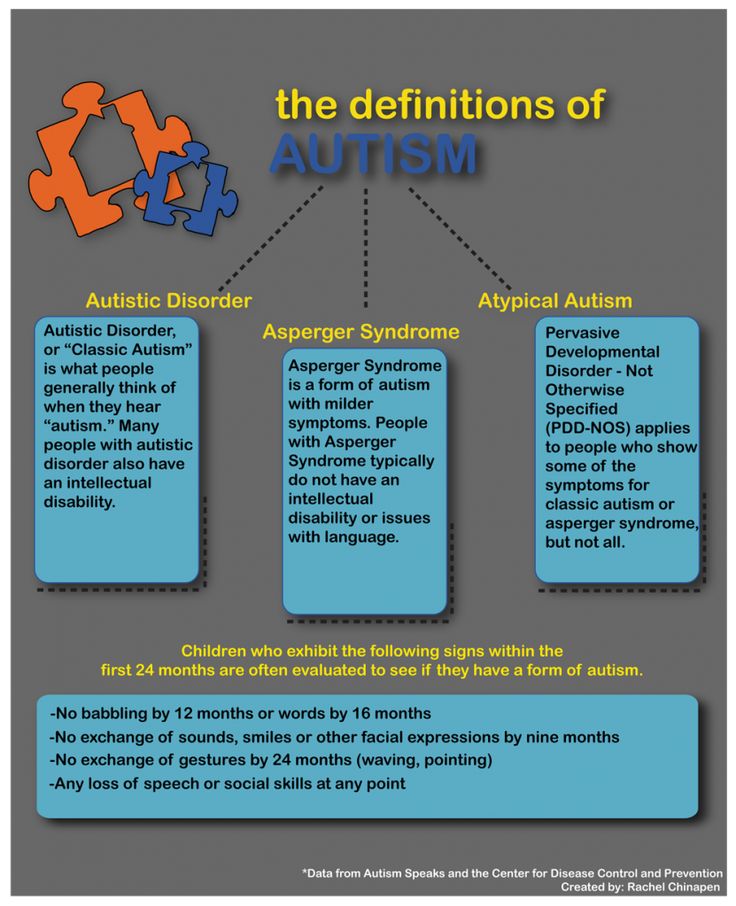 gov) - Aims to improve early identification of children with autism and other developmental disabilities so children and families can get the services and support they need.
gov) - Aims to improve early identification of children with autism and other developmental disabilities so children and families can get the services and support they need.
- Last Updated
- 4/1/2021
- Source
- American Academy of Pediatrics (Copyright © 2021)
The information contained on this Web site should not be used as a substitute for the medical care and advice of your pediatrician. There may be variations in treatment that your pediatrician may recommend based on individual facts and circumstances.
Follow Us
Back to Top
"Children of the rain". What you need to know about autism
11 April 2019 12:01
Behind the poetic expression "children of the rain" lies the daily feat of people who are faced with a diagnosis of autism.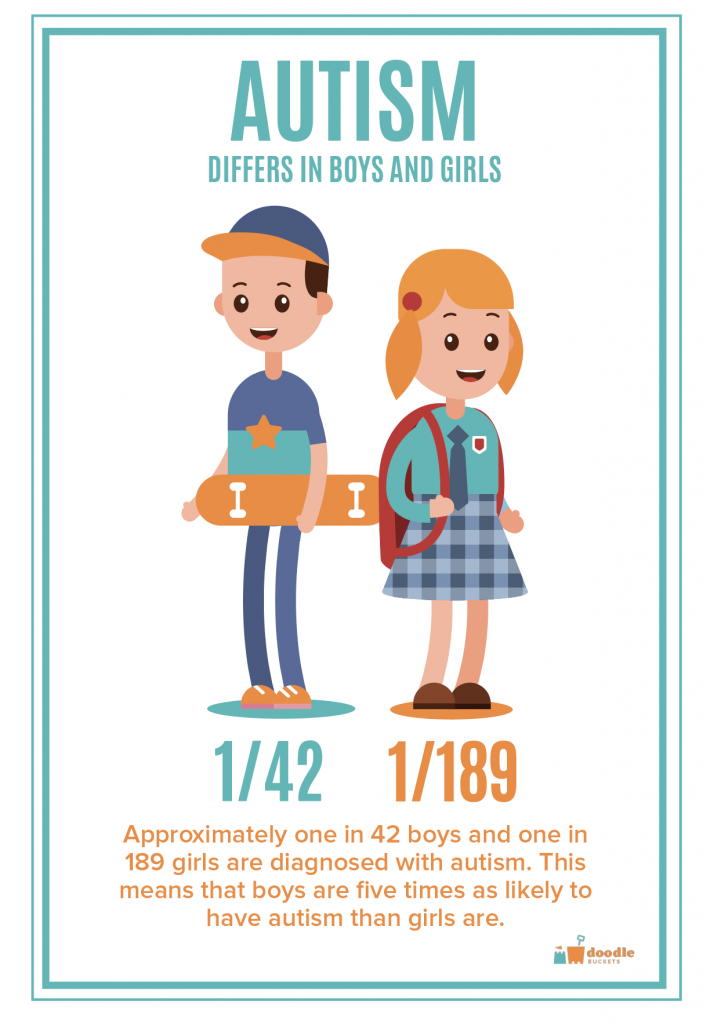 Children who will never be able to perceive themselves as part of the world around them, and parents for whom every day is a series of battles and victories. First, fighting with yourself, accepting and realizing that their child will never be cured, and then fighting the disease for every gesture, every smile, every look and word of the child - small, but such important victories.
Children who will never be able to perceive themselves as part of the world around them, and parents for whom every day is a series of battles and victories. First, fighting with yourself, accepting and realizing that their child will never be cured, and then fighting the disease for every gesture, every smile, every look and word of the child - small, but such important victories.
Scientists have not been able to reliably establish the causes of the disease. It is known about the genetic predisposition: signs of autism are more often manifested in people whose family already has an autistic person. Pregnancy in mothers of such children proceeds normally, and the children themselves are often very attractive in appearance - autism, as a rule, does not affect the physical development of the child. However, the development of autism is still in some cases associated with the manifestation of other diseases:
- cerebral palsy;
- maternal rubella infection during pregnancy;
- tuberous sclerosis;
- impaired fat metabolism (the risk of having a baby with autism is greater in obese women).
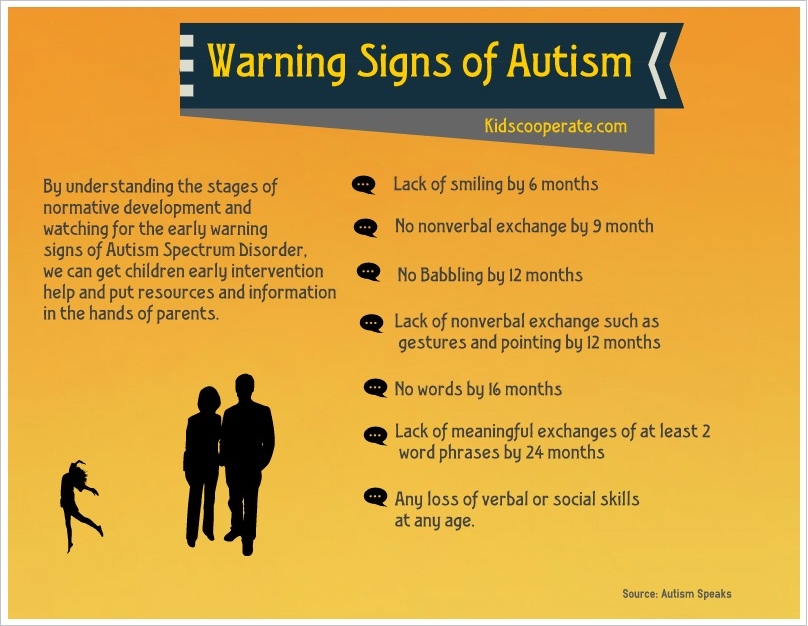
All of these conditions can have a bad effect on the brain and, as a result, provoke symptoms of autism. However, what autism is, and what are the causes of its manifestation, is still not completely clear.
Early diagnosis plays an important role in the further development of an autistic child. Autism in children is manifested by certain signs. Early childhood autism is a condition that can manifest itself in children at a very early age - both at 1 year old and at 2 years old. What is autism in a child, and whether this disease occurs, is determined by a specialist. But you can independently figure out what kind of illness a child has and suspect him, based on information about the signs of such a condition.
Early signs of autism in a child
This syndrome is characterized by 4 main signs. In children with this disease, they can be determined to varying degrees.
Signs of autism in children are as follows:
- impaired social interaction;
- broken communication;
- stereotyped behaviour;
- early symptoms of childhood autism in children under 3 years of age.

The first signs of autistic children can be expressed as early as the age of 2 years. Symptoms may be mild when eye-to-eye contact is impaired, or more severe when it is completely absent. As a rule, autism manifests itself very early - even before the age of 1, parents can recognize it. In the first months, such children are less mobile, react inadequately to stimuli from the outside, they have poor facial expressions.
The child cannot perceive a holistic image of a person who is trying to communicate with him. Even in the photo and video, you can recognize that such a baby's facial expressions do not correspond to the current situation. He does not smile when someone tries to amuse him, but he can laugh when the reason for this is not clear to anyone close to him. The face of such a baby is mask-like, grimaces periodically appear on it.
Baby uses gestures only to indicate needs. As a rule, even in children under one year old, interest is sharply shown if they see an interesting object - the baby laughs, points with a finger, and demonstrates joyful behavior.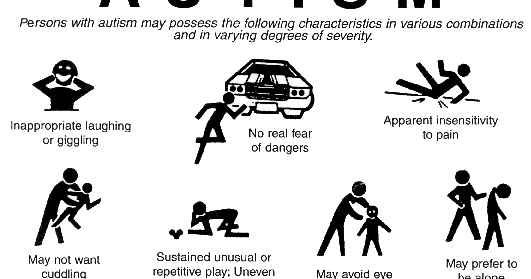 The first signs in children under 1 year old can be suspected if the child does not behave like this. Symptoms of autism in children under one year old are manifested by the fact that they use a certain gesture, wanting to get something, but do not seek to capture the attention of their parents by including them in their game.
The first signs in children under 1 year old can be suspected if the child does not behave like this. Symptoms of autism in children under one year old are manifested by the fact that they use a certain gesture, wanting to get something, but do not seek to capture the attention of their parents by including them in their game.
An autistic person cannot understand other people's emotions. How this symptom manifests itself in a child can be traced already at an early age. If ordinary children have a brain designed in such a way that they can easily determine when they look at other people, they are upset, cheerful or scared, then an autistic person is not capable of this.
The child is not interested in peers. Already at the age of 2, ordinary children strive for company - to play, to get acquainted with their peers. Signs of autism in children of 2 years old are expressed by the fact that such a baby does not participate in games, but plunges into his own world. Those who want to know how to recognize a child 2 years old and older should simply look at the company of children: an autist is always alone and does not pay attention to others or perceives them as inanimate objects.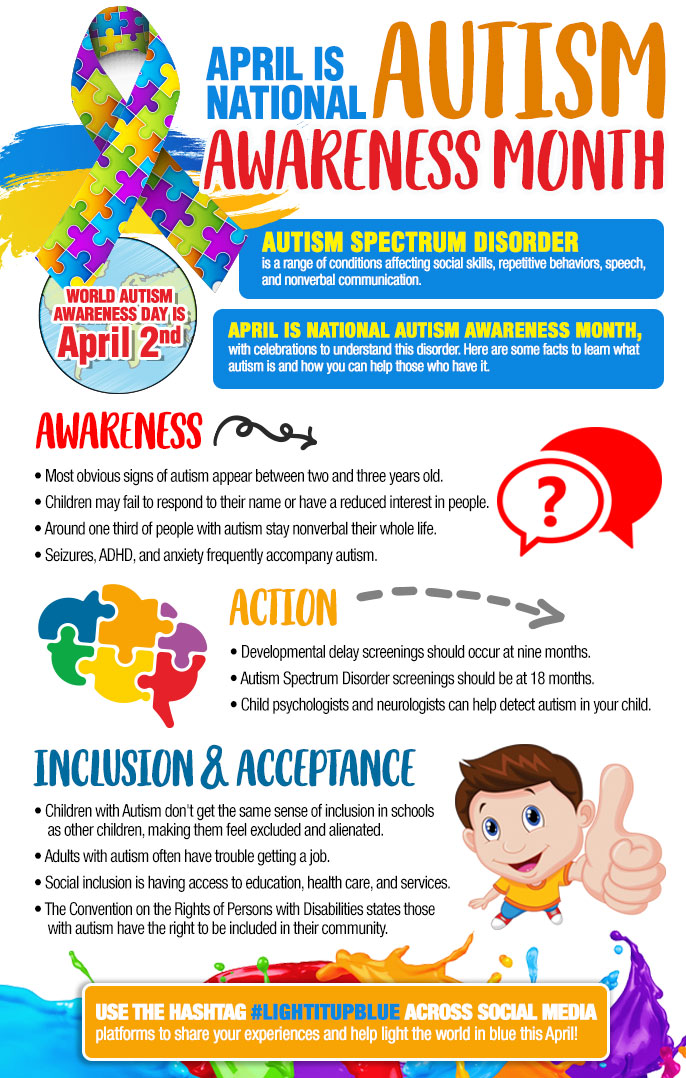
It is difficult for a child to play with imagination and social roles. Children 3 years old and even younger play, fantasizing and inventing role-playing games. In autistics, symptoms at 3 years old may be expressed by the fact that they do not understand what a social role in the game is, and do not perceive toys as integral objects. For example, signs of autism in a child of 3 years old can be expressed by the fact that the baby spins the wheel of a car for hours or repeats other actions.
Child does not respond to emotions and communication from parents. Previously, it was believed that such children are not emotionally attached to their parents at all. But now scientists have proven that when a mother leaves, such a child at 4 years old and even earlier shows anxiety. If family members are around, he looks less obsessed. However, in autism, signs in children of 4 years old are expressed by a lack of reaction to the fact that parents are absent. The autist shows anxiety, but he does not try to return his parents.
In children under 5 years of age and later, there is a delay in speech or its complete absence (mutism). The speech is incoherent, the child repeats the same phrases, devoid of meaning, speaks of himself in the third person. He does not respond to other people's speech either. When the “age of questions” comes, parents will not hear them from the baby, and if they do, then these questions will be monotonous and without practical significance.
Stereotyped behavior includes obsession with one activity, repetition of daily rituals, development of fears and obsessions. At the same time, if the sequence of the ritual is violated, the child becomes hysterical or may show aggression or self-aggression.
Can autism be cured and is it curable at all? Unfortunately, there is no cure. How you can help your child depends on each individual case. Drug treatment is prescribed only in case of destructive behavior of a small patient. But, despite the fact that the disease is not curable, it is possible to correct the situation.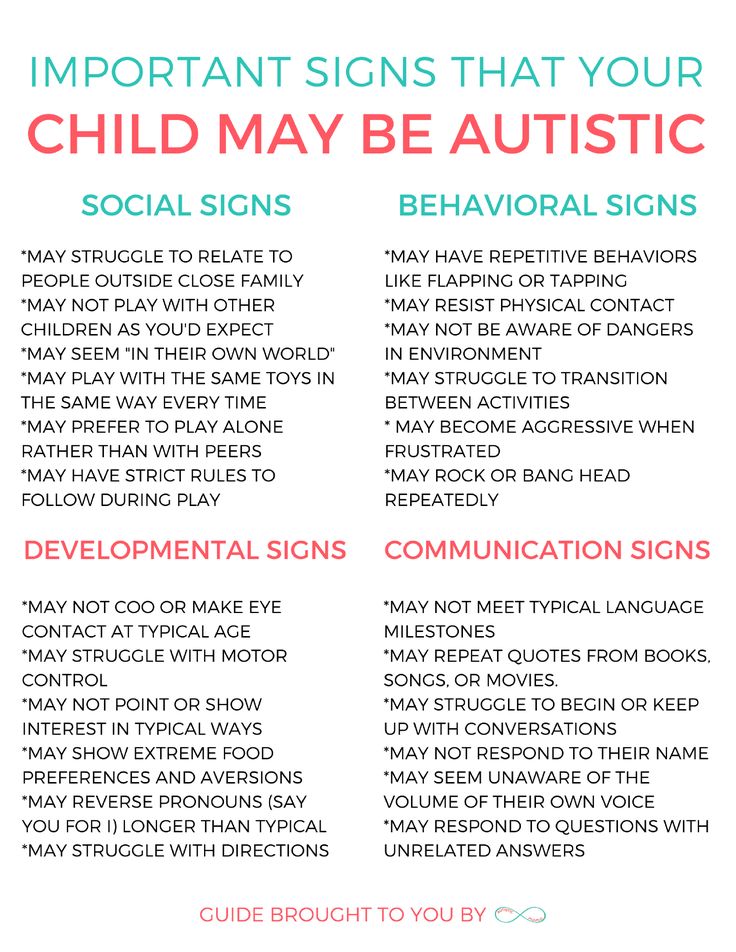 The best "treatment" in this case is regular practice every day and the creation of the most favorable environment for the autistic. Classes are held in stages:
The best "treatment" in this case is regular practice every day and the creation of the most favorable environment for the autistic. Classes are held in stages:
- To form the skills that are needed for training. If the child does not make contact, gradually establish it, not forgetting who it is - autistics. Gradually it is necessary to develop at least the rudiments of speech.
- Eliminate forms of behavior that are non-constructive: aggression, self-aggression, fears, withdrawing into oneself, etc.
- Learn to observe, imitate.
- Teaching social games and roles.
- Learn to make emotional contact.
The most common treatment for autism is practiced according to the principles of behaviorism (behavioral psychology). One of the subtypes of such therapy is ABA therapy. The basis of this treatment is to observe what the reactions and behavior of the baby look like. After all the features are studied, incentives are selected for a particular autist. Speech therapy practice is obligatory: if the kid regularly works with a speech therapist, his intonation and pronunciation are getting better. At home, parents help the child develop self-service and socialization skills. Since autists have no motivation to play, they get used to the daily routine, everyday affairs, cards are created where the order of performing this or that action is written or drawn.
Speech therapy practice is obligatory: if the kid regularly works with a speech therapist, his intonation and pronunciation are getting better. At home, parents help the child develop self-service and socialization skills. Since autists have no motivation to play, they get used to the daily routine, everyday affairs, cards are created where the order of performing this or that action is written or drawn.
Why is early diagnosis important? There are conditions that mimic autism that can be confused with its symptoms. But other methods are used to correct them.
ZPRR with autistic features
The symptoms of this disease are associated with a delay in psychoverbal development. They are in many ways similar to the signs of autism. Starting from a very early age, the baby does not develop in terms of speech in the way that existing norms suggest. In the first months of life, he does not babble, then he does not learn to speak simple words. At 2-3 years old, his vocabulary is very poor. Such children are often poorly developed physically, sometimes hyperactive. The final diagnosis is made by the doctor. It is important to visit a psychiatrist, speech therapist with the child.
Such children are often poorly developed physically, sometimes hyperactive. The final diagnosis is made by the doctor. It is important to visit a psychiatrist, speech therapist with the child.
Attention deficit hyperactivity disorder
This condition is also often mistaken for autism. With a lack of attention, children are restless, it is difficult for them to study at school. There are problems with concentration, such children are very mobile. Even in adulthood, echoes of this state remain, because it is difficult for such people to remember information and make decisions. You should try to diagnose this condition as early as possible, practice treatment with psychostimulants and sedative drugs, and visit a psychologist.
Hearing loss
These are various hearing impairments, both congenital and acquired. Hearing-impaired children also have speech delays. Therefore, such children do not respond well to the name, fulfill requests and may seem naughty.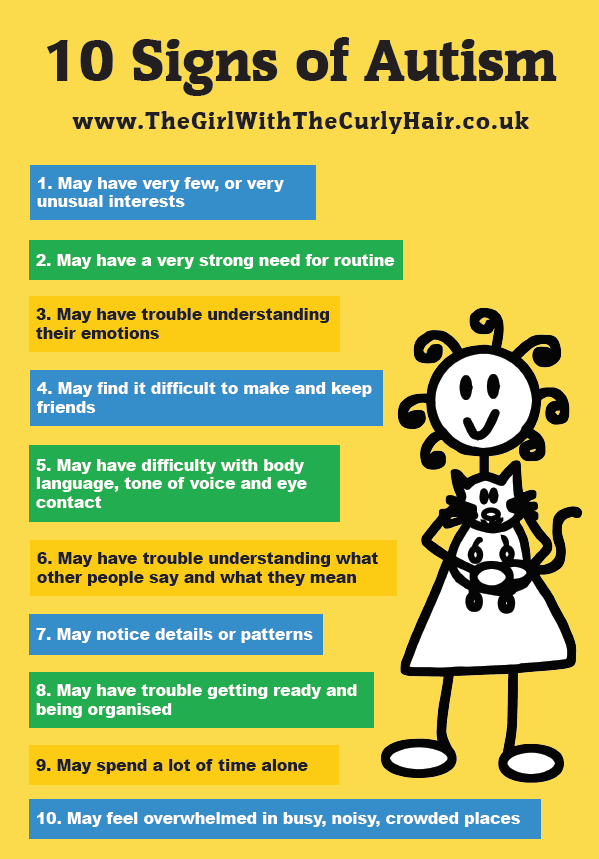 At the same time, parents may suspect autism in children. But a professional psychiatrist will definitely send the baby for an examination of auditory function.
At the same time, parents may suspect autism in children. But a professional psychiatrist will definitely send the baby for an examination of auditory function.
Hearing aid helps solve problems.
Schizophrenia
Autism was previously considered one of the manifestations of schizophrenia in children. However, it is now clear that these are two completely different diseases. Schizophrenia in children begins later - at 5-7 years. The symptoms of this disease appear gradually. Such children have obsessive fears, talk to themselves, later delusions and hallucinations appear. This condition is treated with medication.
It is important to understand that autism is not a death sentence. Indeed, with proper care, the earliest correction of autism and support from specialists and parents, such a baby can fully live, learn and find happiness, becoming an adult.
Early signs of autism in children
Children's Medical Center of Neurology and Pediatrics offers you a service - diagnosis of early autism in children. Our experts have many years of experience and excellent reviews!
Our experts have many years of experience and excellent reviews!
Signs of early autism in children can manifest themselves quite differently, but the disease and symptoms are individual. In some cases, the early signs of autism can even be confused with the good behavior of the baby: he is undemanding, calm and independent. Therefore, you should pay attention to whether your child corresponds to the main stages of development of peers. There are a number of markers that need to be highlighted.
Signs of early autism in children under 1 year old:
- By the age of 6 months, the child does not show obvious emotions, even meeting with his mother does not cause him to change his emotional background.
- By 9 months, the baby does not try to babble, does not look for visual contact, it may seem that he is not looking into your eyes, but through you. Does not respond to his name, while in other situations does not show hearing problems. The child does not attempt to initiate or respond to the mother's hugs.
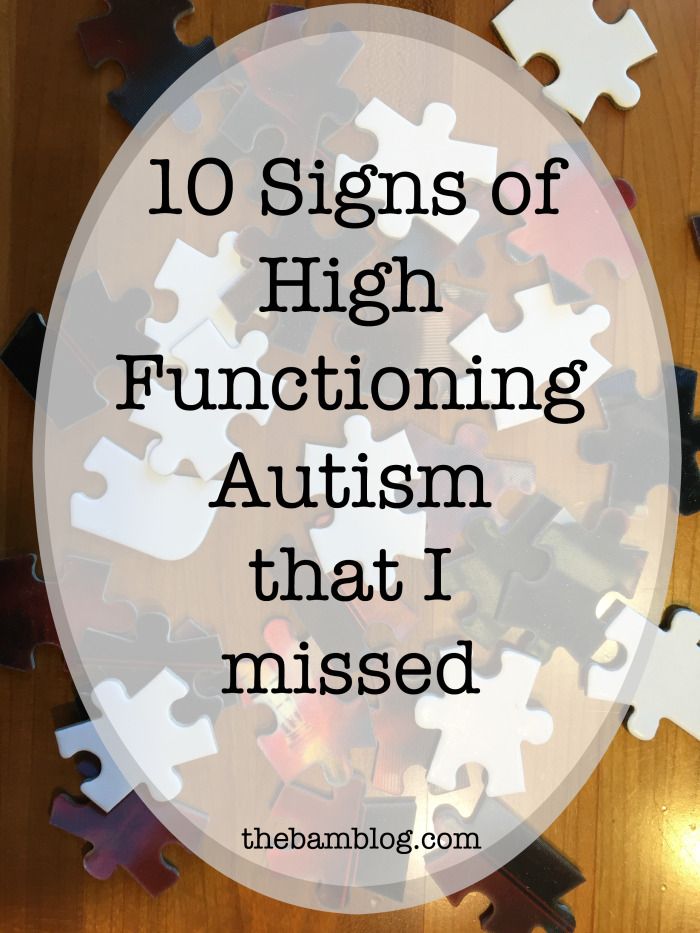 He doesn't even like tactile contact.
He doesn't even like tactile contact. - By the age of 1 year, a delay or lack of development of spoken language is clearly noticeable, not accompanied by attempts to compensate for it with other forms of communication, for example, gestures.
The disease itself, as a rule, manifests itself before the age of two, it is at this age that a diagnosis can be clearly made. However, the sooner we start treatment, the more chances for a fruitful result!
Signs of early autism in children 2 years old:
- The child does not point to objects that could interest him in the world around him. At the age of 14-16 months, ordinary children actively use sign language.
- Does not understand simple one-step instructions, such as asking to show where a block or toy is.
- The kid does not use speaking skills, there are often cases when the child goes into some kind of regression, i.e. before that, he tried to show verbal activity and suddenly begins to lose verbal skills.
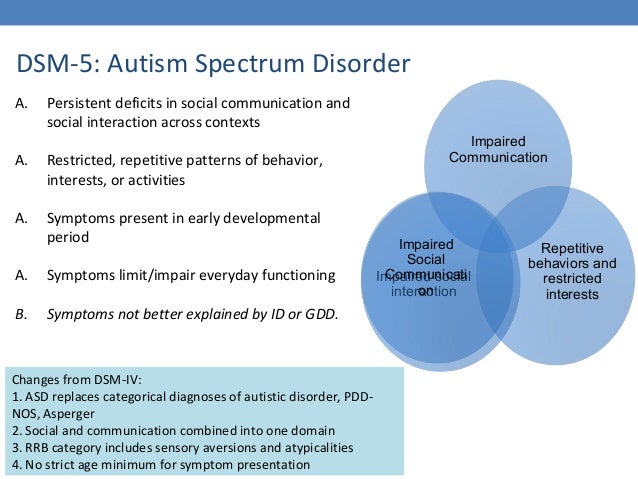 Similar cases of regression occur in the social field, as if the child withdraws into himself.
Similar cases of regression occur in the social field, as if the child withdraws into himself. - Quite often the child limits his motor activity.
- Shows emotions in a way that others do not understand, for example, may laugh or cry inappropriately.
Signs of early autism in a child of 3 years old:
The older the child becomes, the stronger the symptoms, here we can already talk about the current picture of the disease.
- During everyday play, a child with early autism tends to focus on one object or detail, i.e. he may be interested only in the wheel of the machine. Therefore, he does not carry the machine on the carpet, but simply turns its wheel with his fingers. Thus, all games look one-sided, they are devoid of creativity and fantasy.
- Interested in unusual objects or activities.
- Such a child likes the same type of movements, for example, flipping through a book, playing with a switch, turning the lights on and off in the room repeatedly.
 He spends a lot of time arranging objects in a certain order.
He spends a lot of time arranging objects in a certain order. - He does not understand games related to imitation, he will not participate in pretend play, artistic creativity is not for them.
- They are not interested in games with their peers, they prefer to spend time alone.
- Such a child often uses stereotyped behavior, any deviation from the usual state of affairs can cause a violent reaction, up to hysteria. For example, a simple trip to the store or a walk along a new route can lead to the above described explosion of emotions. The same applies to eating habits, the baby can react sharply to a new dish, refuses to eat many foods.
- Is overly sensitive to various types of external stimulation, for example, external noise, unfamiliar smell, even new clothes or some kind of accessory on it can affect the child's mood. Unexpectedly reacts to the manifestation of painful or irritating factors, from a sharp sound, he may panic, while some real pain syndrome may go unnoticed.

